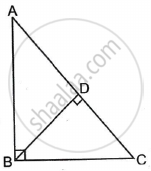Advertisements
Advertisements
प्रश्न
If ΔABC ~ ΔDEF such that AB = 5 cm, area (ΔABC) = 20 cm2 and area (ΔDEF) = 45 cm2, determine DE.
उत्तर
We have,
ΔABC ~ ΔDEF such that AB = 5 cm,
Area (ΔABC) = 20 cm2 and area(ΔDEF) = 45 cm2
By area of similar triangle theorem
`("Area"(triangleABC))/("Area"(triangleDEF))="AB"^2/"DE"^2`
`rArr20/45=5^2/"DE"^2`
`rArr4/9=5^2/"DE"^2`
`rArr2/3=5/"DE"` [Taking square root]
`rArr"DE"=(3xx5)/2=7.5` cm
APPEARS IN
संबंधित प्रश्न
Diagonals of a trapezium ABCD with AB || DC intersect each other at the point O. If AB = 2CD, find the ratio of the areas of triangles AOB and COD.
Two isosceles triangles have equal vertical angles and their areas are in the ratio 36 : 25. Find the ratio of their corresponding heights.
The corresponding altitudes of two similar triangles are 6 cm and 9 cm respectively. Find the ratio of their areas.
In ΔABC, D and E are the mid-points of AB and AC respectively. Find the ratio of the areas of ΔADE and ΔABC
The areas of two similar triangles are 121 cm2 and 64 cm2 respectively. If the median of the first triangle is 12.1 cm, find the corresponding median of the other.
∆LMN ~ ∆PQR, 9 × A (∆PQR ) = 16 × A (∆LMN). If QR = 20 then Find MN.
The perpendicular from A on side BC of a Δ ABC meets BC at D such that DB = 3CD. Prove that 2AB2 = 2AC2 + BC2.
The ratio of corresponding sides of similar triangles is 3 : 5, then find the ratio of their areas.
If ∆ABC ~ ∆PQR and AB : PQ = 3 : 4 then A(∆ABC) : A(∆PQR) = ?
In the adjoining figure, ΔADB ∼ ΔBDC. Prove that BD2 = AD × DC.

